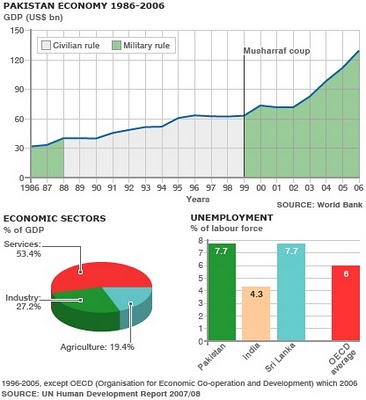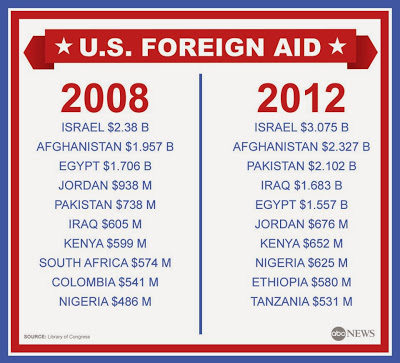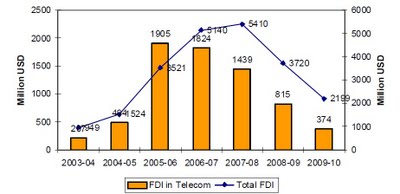Musharraf Earned Legitimacy by Good Governance
By Riaz Haq
CA
Former President Musharraf's detractors argue that he lacked legitimacy because he came to power through a coup which removed a duly elected government in 1999.
Implicit in Musharraf's opponents' argument is the assumption that the electoral process is the only source of legitimacy for a ruler. It ignores the possibility that the will of the people can also be expressed in ways other than elections to confer legitimacy on a leader. It rejects the notion that a leader can earn legitimacy in the eyes of the people by delivering results to the people through good governance .
Public Opinion Surveys:
Such an expression of people's will can come in many forms, including results of frequent public opinion polls conducted by multiple professional pollsters in Pakistan and many other countries around the world. One such credible survey is done regularly by Pew Global Research . It shows that the majority of people believed the country was headed in the right direction in Musharraf years . It also shows that people's satisfaction with Pakistan's direction has been in rapid decline. It has sharply fallen to about 8% in 2013.
Another survey conducted by Gallup Pakistan in August 2013 shows that 59% of Pakistanis have a positive view of President Muaharraf (31% say they hold a favorable opinion of him and another 28% say he was satisfactory). 34% have an unfavorable opinion of the former ruler.
Judiciary and Parliament Approval:
Musharraf's actions of 1999 were legitimized by the Pakistan Supreme Court in Syed Zafar Ali Shah v. General Pervez Musharraf , Chief Executive of Pakistan (PLD 2000 SC 869). In addition to endorsing the coup, the Supreme Court granted extensive powers to the new Musharraf Government, empowering it to unilaterally amend the 1973 Constitution and enact new laws without the approval of Parliament.
Musharraf held parliamentary elections in 2002 and subsequently won a parliamentary vote to confirm him as the President of Pakistan.
Good Governance under Musharraf:
When Musharraf took over in 1999, Pakistan was essentially bankrupt with just a few hundred million dollars in reserves and a heavy debt load which it couldn't repay. Economic growth plummeted to between 3% and 4%, poverty rose to 33%, inflation was in double digits and the foreign debt mounted to nearly the entire GDP of Pakistan as the governments of Benazir Bhutto (PPP) and Nawaz Sharif (PML) played musical chairs. Before Sharif was ousted in 1999, the two parties had presided over a decade of corruption and mismanagement. In 1999 Pakistan’s total public debt as percentage of GDP was the highest in South Asia – 99.3 percent of its GDP and 629 percent of its revenue receipts, compared to Sri Lanka (91.1% and 528.3% respectively in 1998) and India (47.2% and 384.9% respectively in 1998). Internal Debt of Pakistan in 1999 was 45.6 per cent of GDP and 289.1 per cent of its revenue receipts, as compared to Sri Lanka (45.7% and 264.8% respectively in 1998) and India (44.0% and 358.4% respectively in 1998).


So what did Musharraf do to gain the trust of a very large number of Pakistanis who supported his rule after the 1999 coup? He undertook a number of economic and regulatory reforms to rejuvenate the country's economy. Deregulating telecommunications and liberalizing electronic media business, particularly television, immediately brought in the significant first wave of domestic and foreign investment and created media and telecom boom in the country. Banking and financial services sector took off and rapidly grew. A construction boom followed which more than doubled per capita cement consumption and created millions of new jobs.
Thanks to the dynamic economy under President Musharraf's rule , Pakistan created more jobs, graduated more people from schools and colleges, built a larger middle class and lifted more people out of poverty as percentage of its population than India in the last decade. And Pakistan did so in spite of the huge challenges posed by the war in Afghanistan and a very violent insurgency at home.
The above summary is based on volumes of recently released reports and data on job creation , education , middle class size , public hygiene , poverty and hunger over the last decade that offer new insights into the lives of ordinary people in two South Asian countries. It adds to my previous post titled "India and Pakistan Contrasted in 2010" .

The PPP government summed up General Musharraf's accomplishments well when it signed a 2008 Memorandum of Understanding with the International Monetary Fund which said: "Pakistan's economy witnessed a major economic transformation in the last decade. The country's real GDP increased from $60 billion to $170 billion, with per capita income rising from under $500 to over $1000 during 2000-07". It further acknowledged that "the volume of international trade increased from $20 billion to nearly $60 billion. The improved macroeconomic performance enabled Pakistan to re-enter the international capital markets in the mid-2000s. Large capital inflows financed the current account deficit and contributed to an increase in gross official reserves to $14.3 billion at end-June 2007. Buoyant output growth, low inflation, and the government's social policies contributed to a reduction in poverty and improvement in many social indicators". (see MEFP , November 20, 2008, para 1)
Contrary to what Musharraf bashers dismiss as "aid-fueled economy" in 2002-2007, the economic growth was actually driven by private savings and investments. Private domestic savings rate was over 18% of GDP in the Musharraf era but has slumped to just 7% in recent years. Pakistan attracted record foreign direct investment (FDI) in telecom, banking, manufacturing and other sectors of the economy. As for US aid during and after Musharraf's years in office, it has actually tripled in size from $700 million in 2007-8 to $2.1 billion since 2010. If aid alone were responsible for economic growth, then the GDP growth rate should have accelerated, not plummeted, after Musharraf left office.

In addition to the economic revival, Musharraf focused on social sector as well. Pakistan's HDI grew at an average rate of 2.7% per year under President Musharraf from 2000 to 2007, and then its pace slowed to 0.7% per year in 2008 to 2012 under the elected politicians, according to the 2013 Human Development Report titled “The Rise of the South: Human Progress in a Diverse World”.
Overall, Pakistan's human development score rose by 18.9% during Musharraf years and increased just 3.4% under the elected leadership since 2008. The news on the human development front got even worse in the last three years, with HDI growth slowing down as low as 0.59% — a paltry average annual increase of under 0.20 per cent.
Going further back to the decade of 1990s when the civilian leadership of the country alternated between PML (N) and PPP, the increase in Pakistan's HDI was 9.3% from 1990 to 2000, less than half of the HDI gain of 18.9% on Musharraf's watch from 2000 to 2007 .
Acceleration of HDI growth during Musharraf years was not an accident. Not only did Musharraf's policies accelerate economic growth, helped create 13 million new jobs, cut poverty in half and halved the country's total debt burden in the period from 2000 to 2007, his government also ensured significant investment and focus on education and health care . The annual budget for higher education increased from only Rs 500 million in 2000 to Rs 28 billion in 2008, to lay the foundations of the development of a strong knowledge economy, according to former education minister Dr Ata ur Rehman . Student enrollment in universities increased from 270,000 to 900,000 and the number of universities and degree-awarding institutions increased from 57 in 2000 to 137 by 2008. In 2011, a Pakistani government commission on education found that public funding for education has been cut from 2.5% of GDP in 2007 to just 1.5% - less than the annual subsidy given to the various PSUs including Pakistan Steel and PIA, both of which continue to sustain huge losses due to patronage-based hiring .
Constitution Not Suicide Pact:
To those who say nothing should trump the constitution of Pakistan, let me remind them that there is legal precedent to suggest that there are things more important than the constitution. "The Constitution is not a suicide pact" is an oft-repeated phrase in American political and legal discourse. It refers to the belief that constitutional restrictions on governmental power must be balanced against the need for survival of the state and its people. It is frequently attributed to Abraham Lincoln who is said to have used it in answering charge that he violated the United States Constitution by suspending habeas corpus during the American Civil War. Others who have used it include Justice Robert H. Jackson (Terminiello v. Chicago, 1949) and Justice Arthur Goldberg (Kennedy v. Mendoza-Martinez, 1963).
------------------------------------------------------------------------------
Back to Pakistanlink Homepage

